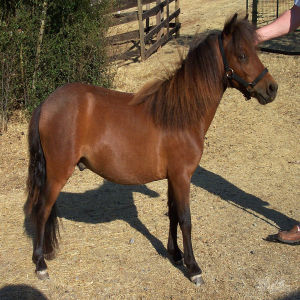 In the 18th century, miniature horses were used to pull carts in the coal mines in Northern Europe. The first herd of miniatures were brought to the U.S. in the 1930’s and used in the coal mines until the late 1950’s. They are very strong, hardy, horses. Miniature horses cannot take a lot of weight on their backs. They are a breed of pony intended to resemble a scaled-down horse. They have been bred for the desired properties of small size, friendly temperament, and horse-like build. Miniature horses can grow up to 34” high at the withers (the highest point of the shoulder). They have an average life span of 25 to 35 years.
In the 18th century, miniature horses were used to pull carts in the coal mines in Northern Europe. The first herd of miniatures were brought to the U.S. in the 1930’s and used in the coal mines until the late 1950’s. They are very strong, hardy, horses. Miniature horses cannot take a lot of weight on their backs. They are a breed of pony intended to resemble a scaled-down horse. They have been bred for the desired properties of small size, friendly temperament, and horse-like build. Miniature horses can grow up to 34” high at the withers (the highest point of the shoulder). They have an average life span of 25 to 35 years.
Location: Australian Adventure
Share:
Range
Originally bred in Europe, they are now worldwide.
Habitat
Miniature horses live in pastures and prefer sunshine and a warm climate. When they are in colder climates they tend to grow a long, shaggy coat to keep warm. In the summer the long coat is shed to reveal a short, shiny coat underneath.
Conservation Status
Primary Threats
Gestation
The gestation period is 11 months.
Litter
Foals are born only one per pregnancy.
Behavior
Horses have excellent senses of sight, hearing, and smell. Their sensitive prehensile lips can sort through grains and their acute sense of taste can determine which food source they like to eat. Miniature horses can be trained as draft horses for pulling carts, but most are companion animals for humans.
Reproduction
Horses mate in mid to late spring. Domestically this can be altered with hormones and breeding may be done throughout the year.
Wild Diet
Horses are herbivores and they break down the fibrous grasses of their diet in their large intestine. In the wild they graze on grass and hay.
Zoo Diet

